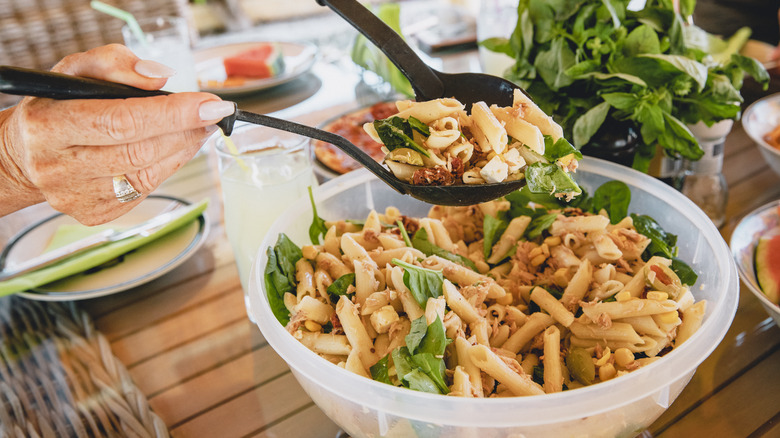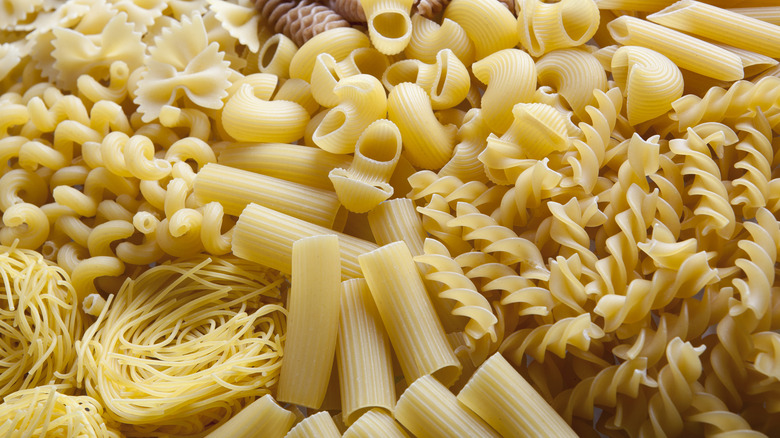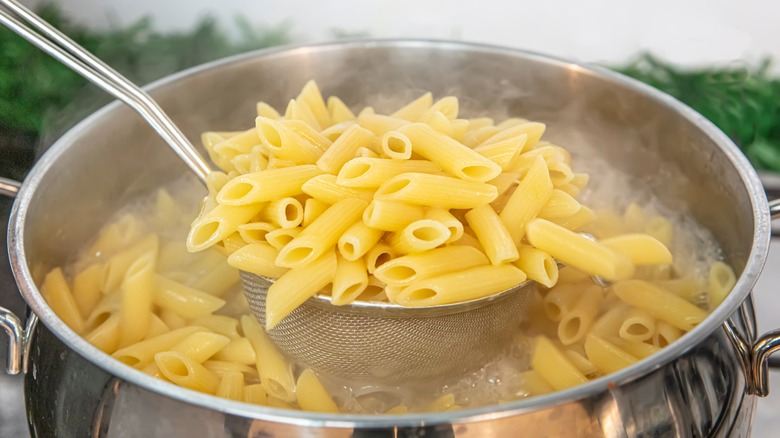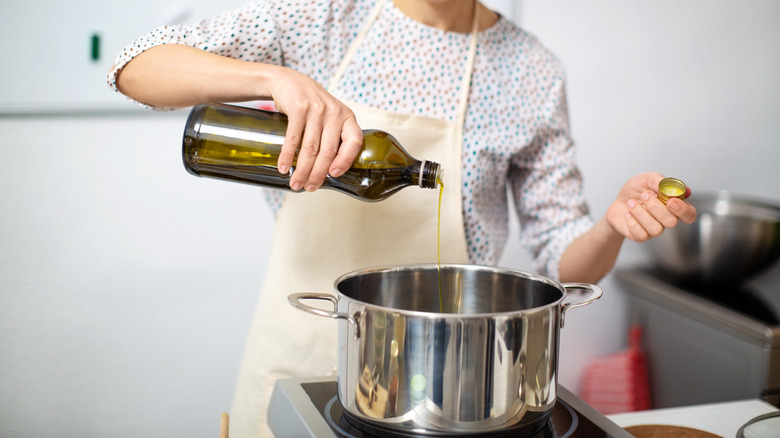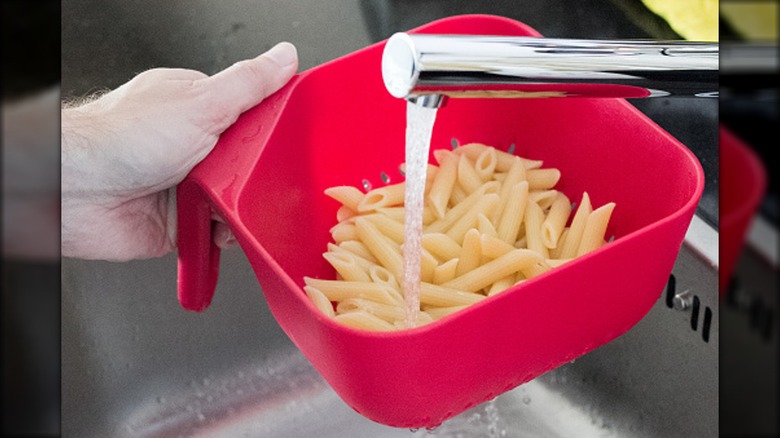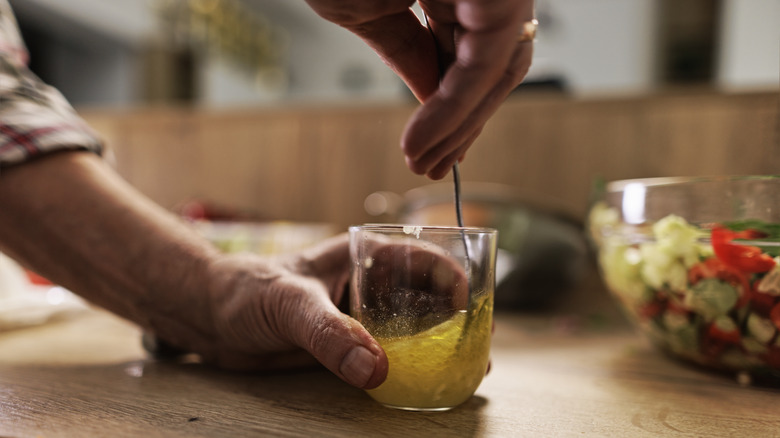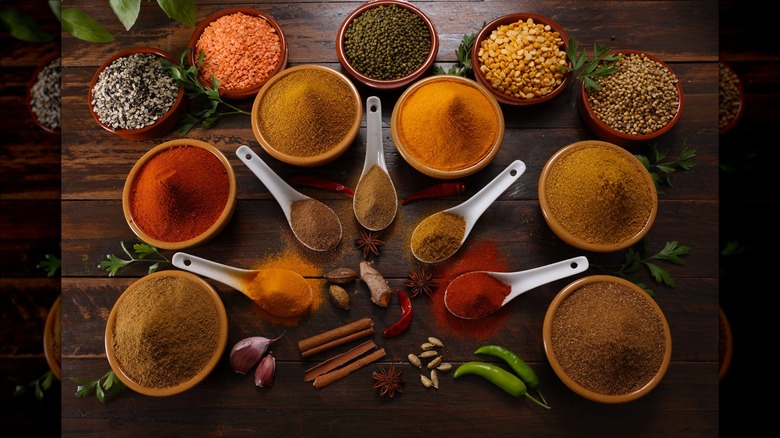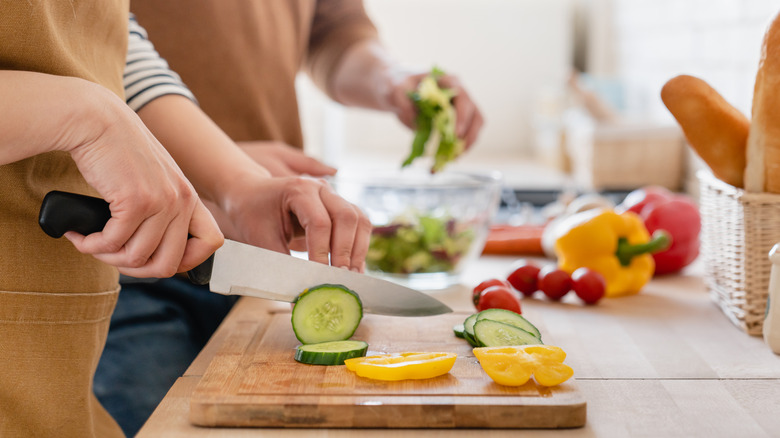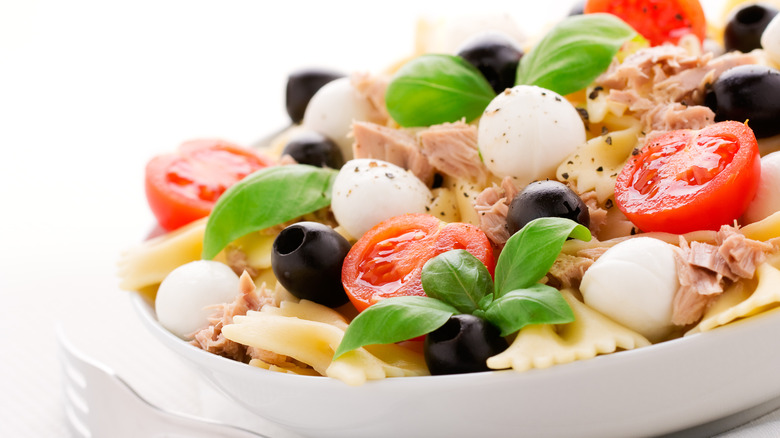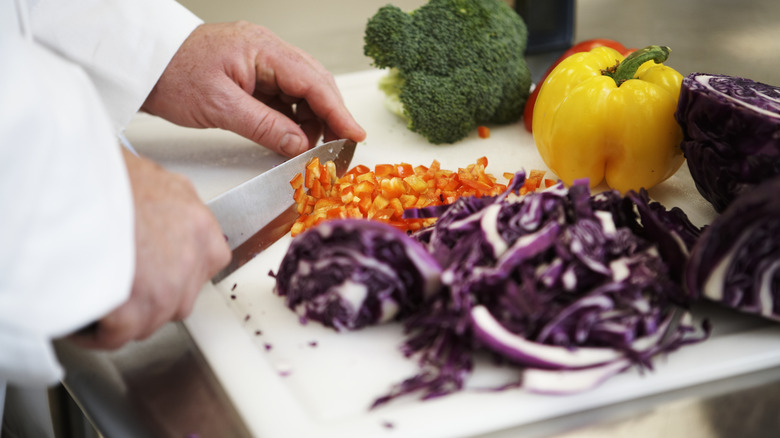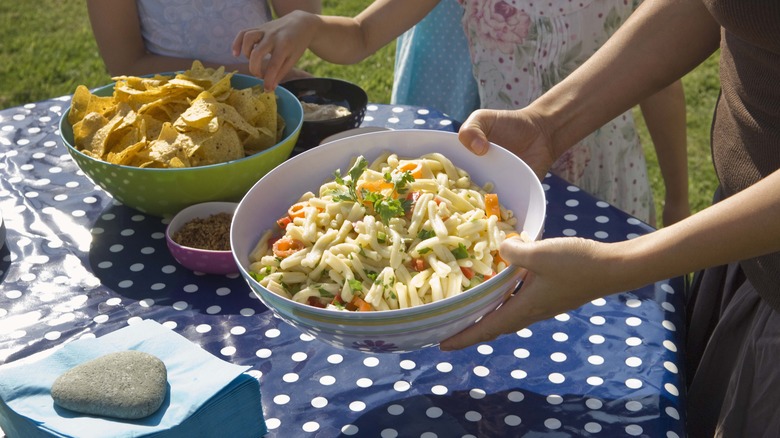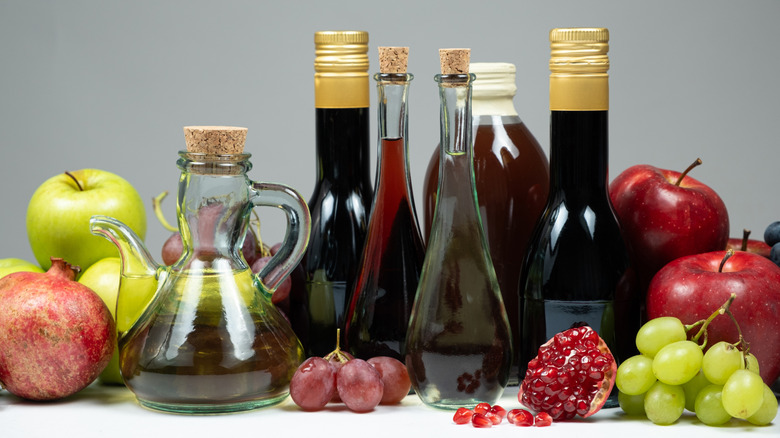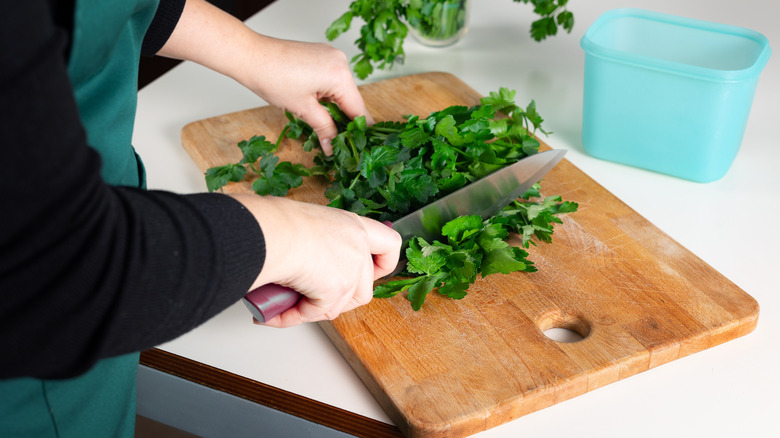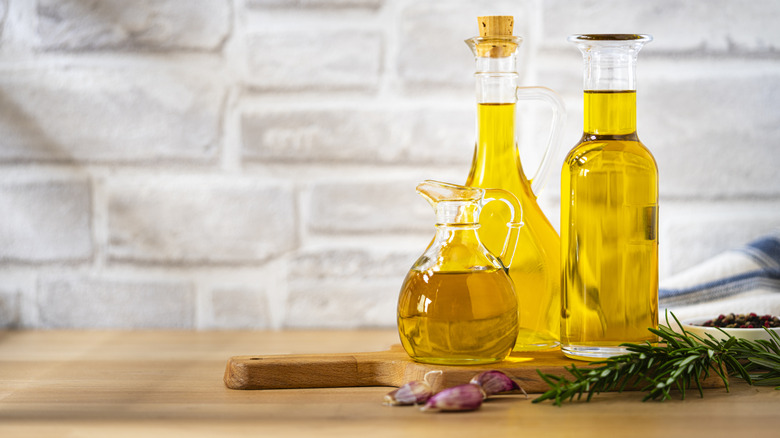Mistakes Everyone Makes When Making Pasta Salad
Pasta salad is a delicious side dish that you'll often find at a picnic or summer barbecue, though you can certainly make it year round. There are several different pasta salad recipes out there featuring various dressings, vegetables, nuts, fruit, and other mix-ins. You can even find recipes for both hot and cold pasta salads. Although many people think of pasta salad as something that is more basic and easy to make, you may be surprised to find out that there are actually several mistakes that are often made when preparing this dish.
These mistakes can cause your pasta salad to be soupy, leave the noodles feeling overly soft and mushy, cause the dressing to clump up, or make it too difficult for your guests to eat. Learning how to avoid these mistakes is crucial if you want to make pasta salad for a small or large group and have it turn out as desired.
Using the wrong pasta shape or size
If you hear pasta salad and assume that you can grab any box of pasta from your pantry to make it, then you've been making a mistake. Despite the name, pasta salad should not be made with just any type of pasta. Some variations won't work as well. For example, try to stay away from rigatoni and other tube-shaped pasta that are on the larger side. With these shapes, too much dressing can get trapped inside the tube, making the flavor of each bite more overwhelming. Long and thin noodles, like spaghetti or angel hair, are also not good candidates when preparing pasta salad. They'll get clumped together and be much more difficult to eat when cold.
Instead, opt for smaller pasta types, such as rotini, fusilli, macaroni, cavatappi, farfalle, or penne. The smaller size of these noodles makes them a much better choice for ensuring a more even ratio of dressing and mix-ins with each bite of the pasta salad. Twisted types of pasta, like rotini, can be an especially great choice because of how the dressing will adhere to the curves.
Not properly cooking the pasta
Once you've selected the right type of pasta, the next mistake you'll want to avoid is not cooking it properly. Cooking your pasta for too long will turn your salad into a mushy mess. Conversely, if you undercook it, the resulting pasta salad will be hard and crunchy — something you certainly don't want.
So, how do you properly cook pasta for pasta salad? Well, one key thing to remember is that you should not cook it exactly as you would if you were preparing a hot dish, such as spaghetti. When you're following a recipe for a cold pasta salad, you'll want to drain the pasta about one minute earlier than you normally would. This way, the pasta will maintain its shape and shouldn't crumble or fall apart when you mix it with the dressing and other ingredients. After draining the pasta, consider spreading it out over a sheet pan to cool and ensure the cooking process has stopped.
Adding oil to the pasta water
You may be in the habit of adding oil to the pasta water when you're preparing spaghetti, fettuccine Alfredo, or other hot entrées. Some believe that this can help keep the noodles from clumping together. However, adding oil to the water is not something that you should do when making pasta salad or any other recipe. The oil will create a film over the pasta as it cools and will prevent the dressing and other flavors from really infusing with it.
If you're worrying about your pasta sticking together when preparing a cold pasta salad recipe, you can do a few things. The first is to wait until the water is boiling before adding the dry pasta to it. And don't add the pasta at the first sign of a few bubbles. Wait until it really gets going and comes to a rolling boil. Then, be sure to stir the pasta immediately after putting it in the pot and then again a few times as it cooks. This will keep the noodles from getting clumped together.
Forgetting to rinse the pasta after draining it
Rinsing pasta when making hot and saucy dishes typically isn't recommended. When you rinse off the cooked and drained pasta, the water removes the starch from the noodles. When this starch is rinsed away, sauces won't stick to the noodles as well, making it more difficult to eat the dish and get the right amount of sauce in each bite. However, this reasoning does not apply when you're making pasta salad that will be served cold.
If you don't rinse the noodles for pasta salad, the starches will cause the noodles to clump up and stick together. This will make it difficult to mix all of the ingredients for the pasta salad together and even more difficult for you and your guests to try to eat it. Individual pieces of macaroni, farfalle, or rigatoni are going to taste much better than trying to break off gummy chunks of cold noodles, don't you think?
Waiting to add the dressing until the pasta is cold
Knowing when to dress your pasta salad is more important than you may think. If the dressing is not applied at the right time, it may not adhere to the rotini or other noodles in the bowl. This can prevent your pasta salad from tasting right because each noodle won't come out of the bowl with enough dressing; rather, there will be a huge puddle of dressing left at the bottom. To avoid this, try adding the dressing while the pasta is still a little warm. This way, the starchy pasta will be able to cling to more of the dressing, keeping it from dripping down to the bottom of the bowl.
Keep in mind, however, that there is an exception to this rule. If the dressing you want to use is mayonnaise-based instead of oil-based, you will want to avoid adding it until the pasta has at least reached room temperature. When mayonnaise-based dressings get warm, they might separate.
Another tip related to dressing your pasta salad is to dress it a second time right before serving. Doing so will help increase the flavor, add some moisture after much of the original round of dressing was absorbed, and make the dish taste fresher.
Adding too much or too little seasoning
Nobody wants to take a bite of pasta salad only to be overwhelmed by too much seasoning or a weird combination of flavors. On the other hand, people also want to feel like what they are eating is flavorful and enjoyable. Thus, striking the right balance of seasoning is something else you'll want to try to do when preparing your recipe.
One important thing to keep in mind when making cold pasta salad is that the seasonings you add will not taste as strong in a cold dish as they would in one that is served hot. For this reason, you may need to use a bit more than you would think. The best way to ensure the right flavor for your pasta salad is to start by adding some extra salt to the water to ensure the noodles taste great. Then, add the seasonings you plan to use, starting with a bit less than you think you would need. Taste the pasta salad and add more seasoning if necessary. Remember, you can always sprinkle a bit more seasoning over the noodles after tasting, but you won't be able to remove any if you end up overdoing it.
Not keeping texture and ratios in mind
The best pasta salad will offer different textures that make each bite an exciting and enjoyable experience. Look for ways to contrast the softer texture of the cooked pasta by incorporating some nuts, seeds, and vegetables into your recipe. While you want the contrast with some chewier items, you don't want to add anything that is overly tough, such as raw cauliflower or broccoli. Blanch these tougher vegetables in a pot of hot and boiling water for a few minutes before mixing them into your recipe.
Once you've planned for different textures, consider ratios. Again, you'll need to strike the right balance here by incorporating enough of these other ingredients into your pasta salad without making them too overwhelming. As a general rule, aim to add about six cups total of vegetables, nuts, proteins, and any other mix-ins for each pound of pasta you cook.
Not adding the right type of cheese
Cheese is one ingredient that can make or break your pasta salad. It can up the flavor, add an exciting texture, increase the protein content, and more. That is, as long as you choose the right type of cheese and cut it properly. When choosing cheese to add to your pasta salad, consider the texture it will provide, how it will add — or detract — from the appearance of the dish, and its melting point (if you're making a hot pasta salad).
If you want to add more texture and flavor, parmesan or other hard cheese can be a good option. Mozzarella and ricotta can also work well in pasta salad if your goal is a creamier finished product. Adding something like blue cheese or feta cheese that will crumble and integrate more fully with the other ingredients can also be a good option to ensure each bite has a little of the cheese flavor. Just don't go overboard with cheese and add just one type to each recipe. Look for the best complement to the other ingredients and the flavor profile.
When preparing hard cheeses to add to your pasta salad, you'll want to avoid placing huge chunks in the bowl. The cheese just won't taste right when covered with the dressing, plus it can make the whole dish more difficult to eat. Instead, grate or shred your harder cheeses to ensure a more even distribution and better texture.
Not cutting your vegetables properly
Another mistake you'll want to avoid when preparing pasta salad is not cutting the vegetables properly. You want to make sure that each veggie is cut to a size that is appropriate and that will enhance the overall dish, not make it less enjoyable or too difficult to eat. While veggies, such as broccoli, carrots, and tomatoes, can really elevate the flavor and texture of pasta salad, no one wants to pick up a forkful from their bowl and realize that it is just one huge veggie chunk. However, your guests will also want to be able to actually see and taste the veggies, not feel like they're so tiny that they're hardly there at all.
To avoid both of these potential problems, learning the proper size to cut each vegetable to is important. As a general rule, you should aim to make the veggies about the same size or a touch smaller than the pieces of pasta (rotini, macaroni, etc.) in your dish. This way, each bite will be more balanced and enjoyable.
Leaving the pasta salad out for too long when serving
One mistake that many people make with pasta salad actually has nothing to do with preparing it but relates to serving it. When you serve pasta salad, it is essential to make sure that it doesn't sit out for too long. Otherwise, you could be putting your health and the health of those around you at risk. According to the United States Department of Agriculture, foods with perishable ingredients should be included in the refrigerator for up to two hours.
The reason for this relates to something known as the Danger Zone. This temperature ranges between 40 and 140 degrees Fahrenheit when bacteria grow the fastest (potentially doubling every 20 minutes). When pasta salad is out of the fridge for more than two hours, it is more likely to warm up enough to fall within this zone. And, if you're serving your pasta salad outside where temperatures are greater than 90 degrees Fahrenheit, the time it could take to reach the Danger Zone drops to just one hour. So, for backyard picnics and barbecues, be mindful of when you take the pasta salad out of the fridge and when you should make sure that any leftovers are put away.
Not using the right kind of acid/vinegar
As an acid, vinegar plays a crucial role in giving the finished recipe the classic tanginess everyone looks for. However, while most people know they need to add vinegar, many assume they can grab just any bottle of vinegar off a shelf in their pantry and call it a day. However, doing so could spell trouble for your pasta salad if you pick the wrong type of vinegar. Steer clear of distilled white vinegar as you prepare your recipe. Adding this to your pasta salad will be a disastrous mistake because of the overly strong and overpowering flavor.
Now that we understand that basic white vinegar is out, there are a few other more suitable options to consider. But there isn't one "best" variety, as that will vary based on your preferences, the other ingredients in the recipe, and what you want the finished product to taste like.
Red wine vinegar is one popular pick for pasta salad. It delivers a nice tangy flavor to the salad that pairs superbly with the oil in the dressing as well as the vegetables mixed in with the pasta. Aged red wine vinegar can be an even better choice, as the aging process helps even the flavor and bring out more of the fruity notes.
Another type of vinegar that you'll see called for in many pasta salad recipes is apple cider vinegar. While it will still deliver the tang you expect in a pasta salad, its flavor is a bit sweeter. This can make it a good choice for those looking to create a less pungent and more balanced pasta salad.
Failing to consider hardiness when adding different ingredients
Pasta salad is a recipe you can prepare ahead of time. If you're hosting a cookout or signed up to bring a side dish to a potluck, having the recipe prepared early can simplify your life. However, while you can mostly prepare pasta salad a few hours or even the day before you need it, adding all of the ingredients so early can be a mistake.
If added too early, certain ingredients can end up having a negative impact on the overall taste or texture of the salad when you serve it. For this reason, it's essential to take hardiness into account when you decide which ingredients you can mix ahead of time and which are best added right before serving. Onions, celery, and other ingredients that won't turn soggy or wilted if let to sit in the dressing can be combined in advance.
While you can sometimes use dried and fresh herbs interchangeably in a recipe, the timing for adding them to your pasta salad will vary. While dried herbs can be put into the mix hours or a day before serving, you'll want to wait to add fresh herbs until mealtime. Fresh herbs can wilt or turn brown if you include them too early. Watery vegetables, like cucumbers and tomatoes, should also be added right before serving. If you mix them in ahead of time, the entire salad could turn into a soggy and soupy disaster.
Not using quality oil
Just as the right oil is key to thinning out chocolate for dipping, the right oil is crucial if you want your pasta salad to turn out as good as possible. Cheaper oils are cheap for a reason — they have a very plain flavor that won't do anything to add depth to the way your pasta salad tastes. Assuming that all olive oils will deliver the same impact to your final recipe, you may not realize your mistake before it's too late, and your pasta salad is ruined.
The production process for cheap, low-quality olive oils looks quite different from that for premium, more expensive extra virgin olive oils. For example, premium olive oil is often cold-pressed. This process uses much lower temperatures to get the oil out, which helps ensure it remains flavorful and with its nutrient profile still intact.
While it may be more of a splurge, you're unlikely to regret the decision to add a premium extra virgin olive oil to your pasta salad recipe. The flavor profile will just be far superior to that cheaper bottle. It will add depth and complexity with its much fresher flavor with hints of fruit and herbs.
